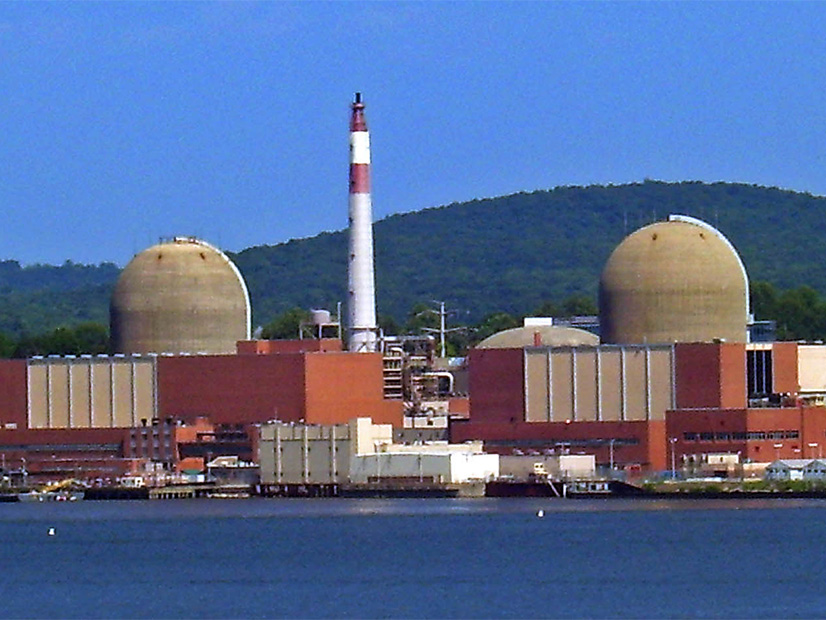
FERC on Thursday rejected a petition by Connecticut resident George Berka against NERC, the Northeast Power Coordinating Council, New York Gov. Andrew Cuomo, NYISO, Entergy, the New York Public Service Commission and Holtec Decommissioning seeking to prevent the closure of Unit 3 at the Indian Point nuclear power plant (EL21-61).
Unit 3 was the last operational reactor at Indian Point, having entered service in 1976. Entergy Nuclear, which owned and operated the plant, informed NYISO in November 2017 that it planned to deactivate it on April 30, a year after deactivating Unit 2.
This was several years after Entergy’s licenses for both plants expired; according to the Energy Information Administration, the utility had sought a 20-year license renewal but reached an agreement with the state of New York in 2017 to retire them in the face of public concerns about their age and safety, along with “low wholesale electricity prices and increased operating costs.” Unit 2 had a nameplate capacity of 1,299 MW, compared to 1,012 for Unit 3. Several natural gas-fired generating facilities have been installed over the last few years to make up the difference.
Berka filed his complaint in March of this year, calling himself a “private citizen concerned about climate change and grid reliability during events of extreme cold in the Northeast.” He said he will be “adversely affected by the closure of the Indian Point units” and asked FERC to order both units be restored to service until at least 2035. He also asked for three immediate temporary injunctions:
-
-
- enjoin Holtec from demolishing or otherwise disturbing Unit 2;
- enjoin Entergy from surrendering its operating license for Unit 3; and
- order Entergy to keep Unit 3 operational until the conclusion of the matter.
-
In addition, Berka suggested that the commission work with other branches of the government to explore “options to nationalize reactors at risk of premature closure.”
He claimed standing to file his complaint under Section 306 of the Federal Power Act based on the fact that he is “likely an end-use customer” of Indian Point’s energy. Berka said that Indian Point’s energy helps to protect him during cold winter weather and extreme weather events because the gas plants that will replace Indian Point have to compete with natural gas demanded for heating while relying on pipelines that are subject to disruption from vandalism or natural events. Those gas units will also generate greenhouse gases that contribute to climate change, further negatively affecting him and other customers, he argued.
The complaint is therefore similar to one filed last year by the advocacy group Californians for Green Nuclear Power (CGNP) that sought to prevent the pending shutdown of the Diablo Canyon Power Plant (EL21-13). CGNP argued that CAISO, NERC and other respondents ignored likely adverse impacts to the bulk electric system and the bulk natural gas system from closing the plant. (See CGNP Fleshes out Diablo Canyon FERC Complaint.)
FERC Warned About Gas Bottlenecks
Berka is also not alone in his concern over the effects of Indian Point’s closure on reliability of the grid: FERC itself warned of potential natural gas bottlenecks last year because of the closure of Unit 2 in its 2020/2021 Winter Energy Market and Reliability Assessment. (See COVID-19, Weather Drive FERC Winter Outlook.) NPCC also noted that NYISO’s total installed capacity for this year’s summer peak week is expected to be down 1,052 MW from last year, mainly because of Unit 3’s retirement. (See NPCC Predicts Lower Peak in Summer 2021.)
But the commission found in its order that the respondents in Berka’s complaint, with the exception of NYISO, were not proper subjects for complaints under Section 306, which allows complaints against “any licensee, transmitting utility or public utility” for possible contraventions of the FPA. FERC agreed with Holtec’s and Entergy’s responsive filings that most of those named by Berka did not fall under any of these categories and therefore dismissed the complaint regarding them — similar to its reasoning for dismissing CGNP’s complaint in March. (See FERC Dismisses Calif. Nuclear Complaint.)
As for NYISO, the commission asserted that Berka had “not satisfied his burden” under the FPA, which requires complainants to “show that any rate, charge, classification, rule, regulation, practice or contract is unjust, unreasonable, unduly discriminatory or preferential.”
Berka, FERC said, claimed “summarily” that replacing Indian Point with fossil fuel units would increase rates and decrease reliability; however, the commission has previously found this type of “speculative allegation” insufficient to satisfy a complainant’s burden. Moreover, Berka did not “identify any relevant reliability standard” or otherwise support his claim that the local and regional power grid would become less reliable because of Indian Point’s closure.
Finally, the commission noted that it does not have jurisdiction over Indian Point at all, as the FPA “explicitly exempts” electricity generation facilities from FERC’s jurisdiction “unless specifically provided for.” As a result, Berka’s requested relief “goes beyond the commission’s jurisdiction” and, therefore, there are no grounds for FERC to grant it.



